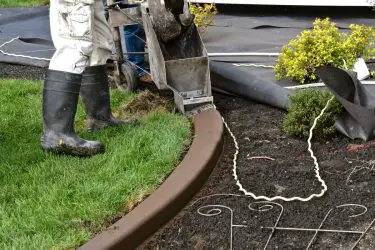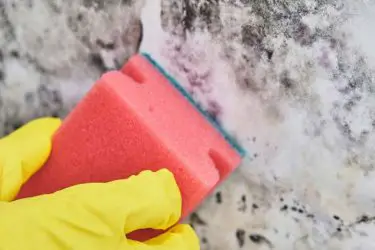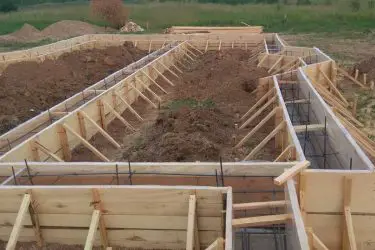Having a concrete pool deck can be incredibly appealing and cost-effective, but do not forget that even the most expensive and cheap materials must be maintained to keep their durability and strength. Concrete pool decks can be remedied in a variety of ways.
Common problems for concrete pool decking are cracking, spalling, or discoloration. Options for solving these common problems range from small caulking jobs to total resurfacing. Fixing the problem will require an analysis of the situation and the proper tools.
While common problems can be fixed easily, we will discuss the repairs for simple things, all the way to complete resurfacing. Either way, concrete can be renewed through the following techniques and with the help of professionals.
If you need to replace the entire pool deck, here’s the average cost to install concrete around your pool.
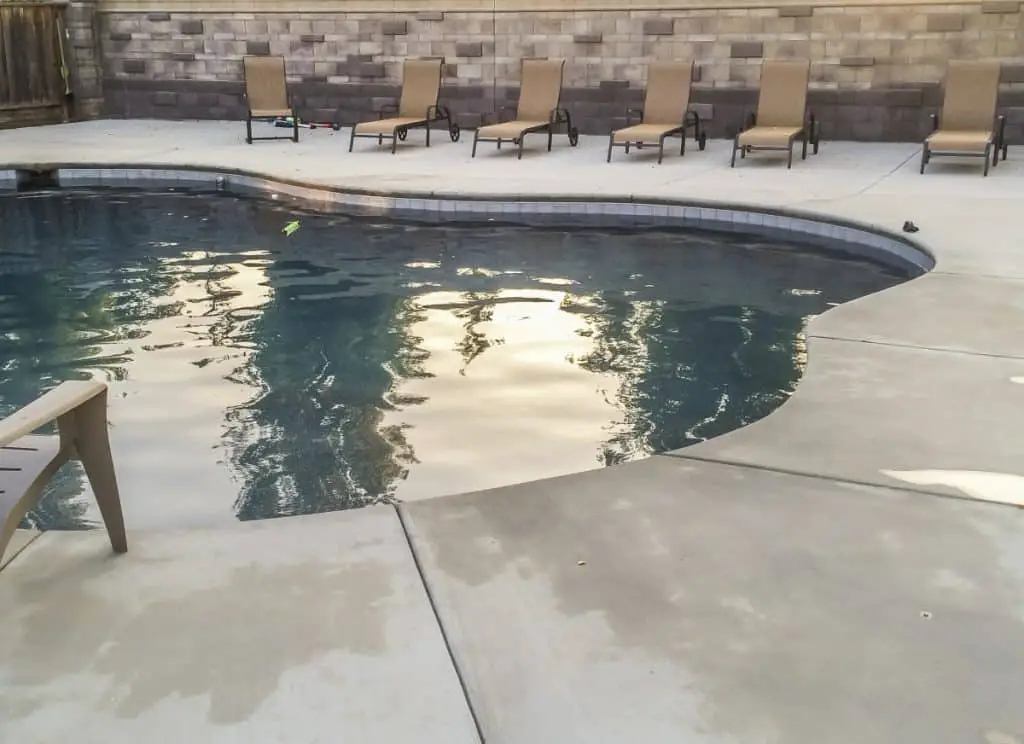
Table of Contents
Cracking on a Pool Deck
Cracking on a pool deck can lead to some problems, but they can also be very minor and require hardly any repair at all. By maintaining simple cracks, you can prevent larger cracks from occurring. There are many causes of cracks, and there are great ways to repair them.
What Causes a Concrete Pool Deck to Crack?
The wet nature of pools can lead to cracking, but regardless of where you are or how wet it is, concrete cracks. There can be a variety of reasons this happens and finding out the cause will help in the solution.
- Freezing and Thawing – Concrete is a very porous material and water gets trapped inside it often. If the water within the concrete freezes, the water will expand by about 10% causing pressure within the concrete and making it crack.
- Poorly Made Concrete – Concrete that contained too much water when it was mixed is often much more fragile than regular concrete. This could be a reason that the concrete is cracking in a variety of places and ways.
- Not Enough Joints – If the concrete slabs were poured without proper placement of control or expansions joints, this can lead to cracking. Normally joints should be placed 2 to 3 times the width of the concrete. For example, if your concrete is 4 inches thick, your spacing should be about 8ft between each joint.
- Structural or Ground Movement – Obviously, an earthquake would disrupt your concrete, but even a little settling can cause cracks. If your soil underneath moves or increases in water concentration, it will cause your concrete to crack.
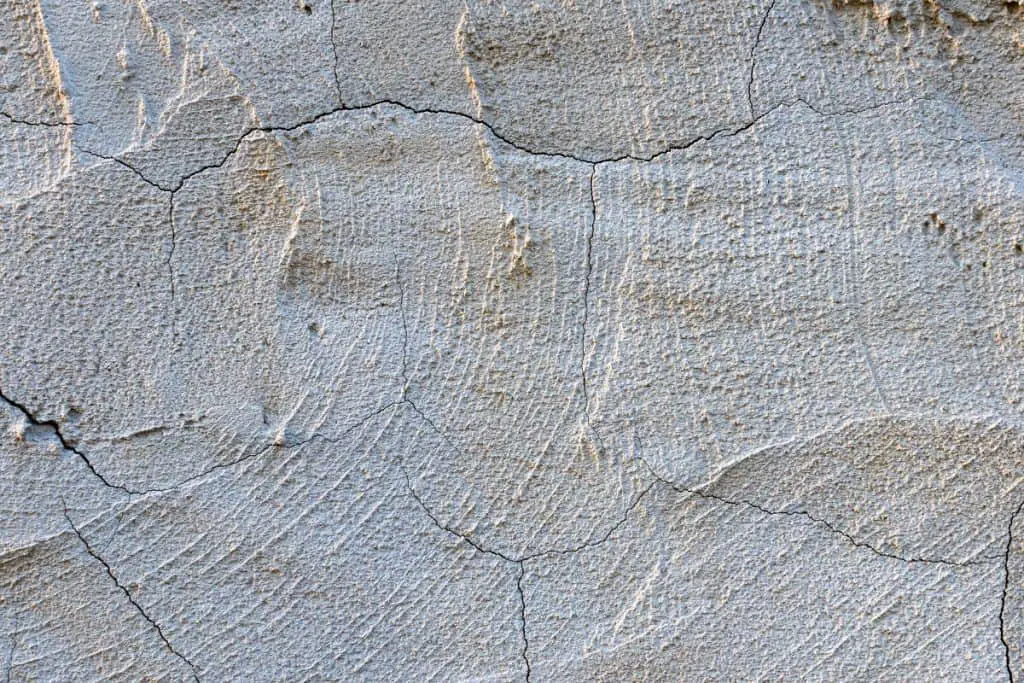
There are other reasons that cracks can occur including deicing salts, which aid in the penetration of water into concrete and allowing more room for freezing and thawing problems. Rebar can also hold the concrete together well, and if it is not present cracks can be more common. Just as freezing and thawing can cause cracks, so can the expansion and contraction that occurs in extreme heat.
How To Repair Concrete Cracks in Pool Decking
1. Chisel And Clean Out The Crack.
Before you begin filling the crack, it is important to chisel around the edges of the crack, maybe even chipping off some cement. This will ensure there is no loose concrete and will allow the new filler to last longer. Clean the crack free of any debris or dust because anything left will ultimately be sealed underneath the new filler and could lead to further damage.
A broom, vacuum, or air compressor can do this. A pressure washer would also do the job, but if that is used be sure that the concrete is completely dry before moving onto the next step.
2. Fill The Crack With A Filler
There is a variety of fillers you can use to fill a crack in the concrete. Choosing the correct concrete crack filler will depend upon the size of your crack. Fillers used for cracks over 1/4 of an inch wide are a concrete patch mix or grout. If the crack is more than 1/4 of an inch wide, a foam backer rod could be considered. Other fillers include mortar, vinyl, or epoxy.
Whichever filler you end up using, be sure to get as deep into the crack as possible and apply pressure to push it deep into the crevices. Do not be afraid to use quite a bit of cement. Following the application smooth off the top and wait for the filler to cure, possibly taking 24 hours.
3. Apply Sealant
Sealing the concrete around the pool can be one of the most important and preventative steps in this process. After waiting for the filler to be completely settled and cured, applying sealant prevents the movement of the crack and further cracking. Because you are fixing a crack surrounding a pool, sealant will be the best protection against the water being splashed around.
When choosing the kind of sealant you want to apply, there are a variety of options. “Some [sealers] are rigid in nature while others are elastomeric in nature, which means that they will stretch or contract as the concrete moves. Flexibleness of sealant products is desirable when sealing cracks in concrete decks.” Source.
Related article: 11 Best Concrete Sealers (and a few mistakes to avoid)
Concrete Spalling on Pool Deck
Concrete spalling is when parts of the larger body of concrete flake off due to damage internal damage. Spalling is evident not only when pieces of your concrete start flaking off, but when aggregate begins to be exposed and chunks start falling out. To solve the problem (or cover it up), you need to either patch the spots or resurface the entire pool deck.
Read more: Why Does Concrete Spall?
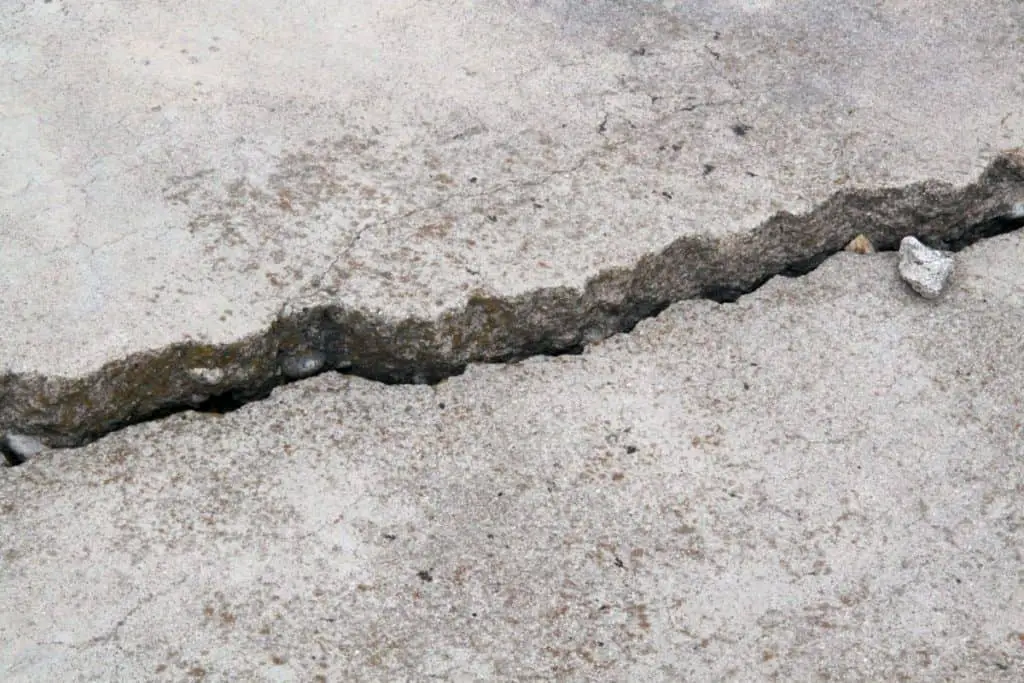
When there are only a few patches of spalling, patching is the best option. Patching is also helpful when the cracks get bigger than 1/4 of an inch. Patching concrete follows the same pattern as filling in cracks. Clean out the area, especially if the flaking is creating dust, and then apply the filler and wait for it to cure.
When hiring a professional, they generally charge anywhere from $250 to 500 dollars for major cracks. Doing it on your own costs around 35 dollars for a bag of concrete patch mix, plus the time and work.
Concrete Discoloration
Discoloration in concrete is often caused by some mistake or underlying condition during the mixing and pouring process. Concrete can turn a variety of colors like blue, red, or yellow. Some can be fixed by washing your concrete. At first, it is good to try just hot water and scrubbing. If this does not work, an acidic solution can be used or, in extreme cases, diammonium citrate.
Another option for concrete discoloration that can’t be washed away is to engrave something into your concrete to distract from the coloring. If your concrete is color stained, and it begins to fade in places, reapplication will be the best option. You can use water or acid-based stain.
Also read: Acid Staining Old Concrete: Is it a good idea? Plus 10 tips!
Other Pool Deck Repairs
Besides the common problems of cracking, spalling, and discolorations, other problems can occur in pool decking and can be addressed in a variety of ways. Preventative measures can also be helpful!
- Sinking Concrete – If your concrete is sinking, rather than completely resurfacing it, you can hire a professional to do a process called slab jacking. Slab jacking is when they drill holes into the concrete and pump extra grout under it until it reaches its desired height. Afterward, they fill back in the drill holes. The base price for such a procedure would be 300 dollars.
- Preventative Measures – If your pool deck is experiencing minor hairline cracks. simply resealing the entire surface will help prevent further damage. To know if your sealant is still doing its job, pour water on it and watch for the concrete to absorb the water, or for it to stay on top. If the concrete absorbs it, you will need to reseal the concrete.
- Sealant Failure – Just as mentioned above, test your sealant and if it needs a new coat, add one to prevent cracks and other problems. You may need to strip the previous sealer, even it is not working, before you apply a new one.
- Slipperiness – If your concrete pool decking is fine other than the occasional slipperiness, add a grit additive to your sealer to add more traction to the concrete. This can help prevent pool-goers from falling, especially when the ground is wet.
Resurfacing A Concrete Pool Deck
If the repairs are not giving you the desired result, or the problems go beyond these simple fixes, resurfacing the concrete would be a good option. Resurfacing allows for a new overall look of your concrete and is simply put as adding another layer of concrete on top of the existing slab. When doing this, you can also change the color or texture of your concrete and add in more preventative measures and texture. Resurfacing decks take about 5 steps.
- Preparation – Grind down the existing concrete and make it smooth or use a chemical to treat the concrete. Doing this will allow the new material to have a great bond to the older one, increasing its durability and strength.
- Cleaning – Pressure wash, sweep, and dust off the slab before you begin.
- Mix – You can either order a pre-existing mix to be laid, or you can mix your own. Either way, if you desire to add color, now is when you would add it in.
- Apply – Once the concrete is mixed and ready, it can be poured or sprayed on. At this point, any decorative engravings should be applied, and the concrete should be left to cure as long as is necessary.
- Sealer – As discussed earlier, sealer can then be added to ensure the new concrete is not as susceptible to cracks and other damage. Be sure to wait for the concrete to be completely cured before applying the sealant.
This does not have to be done yourself though, and a concrete professional would be able to help.
A basic resurfacing job of 750-square-foot pool deck ranges in price from $2,250 to $3,750.
Homeadvisor.com
Finally, all the cracks, spalling, and discoloration of the concrete pool deck can be taken care of. If possible, do the job yourself, but if necessary, a professional can likely give great advice and provide effective repair.

